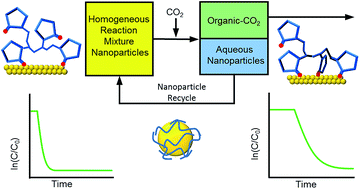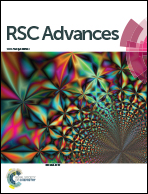Manipulating ligand–nanoparticle interactions and catalytic activity through organic-aqueous tunable solvent recovery†
Abstract
Dispersed gold nanoparticles demonstrate much higher catalytic activities compared to their supported counterparts. Current methods for nanoparticle recovery are difficult to scale up, can alter the morphology of the nanoparticles, require large amounts of energy or solvents, and/or need highly specialized syntheses. Herein, we propose a facile system for the recovery of nanoparticles from reaction mixtures using Organic-Aqueous Tunable Solvents (OATS). OATS are homogeneous mixtures of an organic solvent and water which have the inherent property to phase separate into a heterogeneous mixture under moderate CO2 pressure. A 60 vol% acetonitrile and 40 vol% water mixture was chosen to disperse gold nanoparticles for these experiments. Poly(vinylpyrrolidone) (PVP) was selected because it is water soluble and is believed to allow access to the entire metal surface for reactive compounds. We synthesized gold nanoparticles of average size 9.4 ± 1.4 nm and performed four different thermal treatments (no thermal treatment, 40, 50, 60 °C). The phase separation of the OATS mixture was determined to occur between 9.6 and 11.3 bar of absolute CO2 pressure. Complete recovery of gold nanoparticles was achieved for all thermal treatments based on UV-vis absorbance of the localized surface plasmons collected from each phase. Catalytic activity of the nanoparticles was benchmarked using the hydrogenation of 4-nitrophenol. Reduction of catalytic activity occurred after the nanoparticles underwent thermal treatments or were subjected to pressure separation in OATS but still remained highly active. The decrease in catalytic activity can be attributed to additional PVP functional groups having passivated the surface of the nanoparticles and blocking active sites as the system minimized free energy indicating that PVP does not allow access to the entire nanoparticle surface. The additional surface-bound ligands also prevented precipitation and growth in OATS, but slowed dynamic surface restructuring, ultimately decreasing the apparent catalytic activity.


 Please wait while we load your content...
Please wait while we load your content...